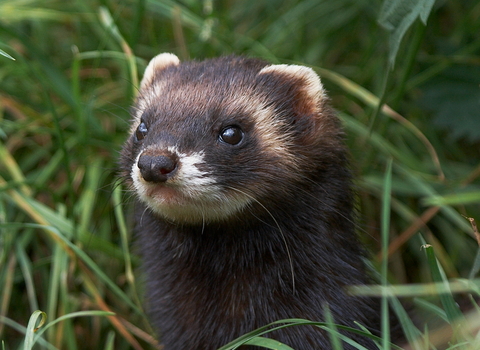
Polecat © Elliot Smith
Polecat
Scientific name
Mustela putoriusWhen to see
January to DecemberSpecies information
About
A member of the mustelid family, which includes the stoat and badger, the polecat is roughly the size of a ferret - its domesticated cousin. Brought to the brink of extinction through persecution, the polecat has been undergoing a recovery recently and can be found in rural Wales and parts of England.Polecats set up home in lowland wooded habitats, marshes, along riverbanks, or even in farm buildings or dry stone walls. They particularly prey on rabbits and may be found in rabbit burrows. They have one litter of five to ten young a year in early summer.
How to identify
The polecat has a two-tone coat: dark brown guard hairs cover a buff-coloured underfur. It has a distinct bandit-like appearance, with white stripes across its dark face. It has a short, dark tail and rounded ears. Polecats do sometimes produce young with escaped ferrets; these hybrids tend to have lighter, creamier fur on their back and more white on their faces, extending past their ears.Distribution
Found in Wales, parts of Scotland, and parts of central, southern and eastern England.In our area
The polecats in Shropshire have displaced escaped hybridised ferrets and have been recorded right across the county. Like all members of the mustelid family of mammals (excluding badgers), polecats are unpredictable to spot but can sometimes be seen hunting for rabbits along vegetated river banks and hedgerows. If you do see a polecat, let Shropshire Mammal Group know by emailing the location and time of sighting to smgrecord@gmail,com
Did you know?
Perceived as bloodthirsty animals, polecats were declared vermin during the reign of Elizabeth I and the name 'polecat' was used to refer to vagabonds. Despite their reputation as pests of poultry, polecats eat small rodents, frogs, birds and snakes during their nocturnal hunting forays. They will slowly stalk their prey, seizing it and killing it with a swift bite to the neck.The polecats in Shropshire have displaced escaped hybridised ferrets and have been recorded right across the county. Like all members of the mustelid family of mammals (excluding badgers), polecats are unpredictable to spot but can sometimes be seen hunting for rabbits along vegetated river banks and hedgerows. If you do see a polecat, let Shropshire Mammal Group know by emailing the location and time of sighting to smgrecord@gmail,com

